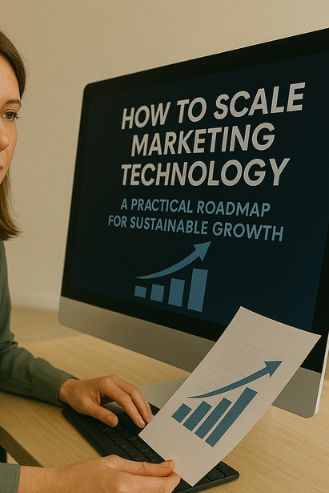
How to Scale Marketing Technology: A Practical Roadmap for Sustainable Growth
Marketers who want to scale marketing technology face a dual challenge: modernizing a fragmented toolset while creating the governance, data quality, and team capabilities required to turn the stack into durable business outcomes. Growth introduces more data, more channels, more stakeholders, and more decisions—so the only way to stay effective is to make the system behind your campaigns measurably more scalable, integrated, and reliable over time.
Early-stage teams can get a long way with a handful of point tools and manual workflows. But as volume rises, the cracks show: inconsistent data, channel silos, duplicate audiences, unclear ownership, and rising costs. If you’re at this inflection point, start by zooming out from tools and clarifying the outcomes you want to scale. For additional perspective on expanding programs as your company grows, this concise guide to scaling marketing highlights the operational foundations that make technology investments pay off.

Start with outcomes and constraints
Before purchasing or re-architecting anything, define what “scaled” looks like in business terms. Is it 3x campaign throughput with the same headcount? A 20% lift in conversion efficiency? Global personalization that respects regional privacy laws? Translate these ambitions into measurable success criteria and constraints—budget, timelines, security, data residency, and change risk. These factors will drive every downstream decision about platforms, integrations, and processes.
Most importantly, anchor your scope in data and learning loops. A stack that can’t close the loop between exposure, engagement, conversion, and LTV will deteriorate as you grow. Adopting a rigorous, data‑driven marketing strategy ensures your scaling efforts compound instead of merely multiplying complexity.
Build a trustworthy data foundation
Every scalable martech stack rests on clean, governed, and portable data. Prioritize identity resolution (deduplicating contacts across sources), a universal data schema (event and attribute definitions), and clear taxonomy (naming conventions for campaigns, channels, UTM parameters). Decide what lives in your source of truth (often a warehouse or CDP) versus what lives at the edge (channel tools). If your CRM, analytics, and ad platforms each maintain their own audience logic, you’ll fight drift and inconsistency as volume grows.
Key data practices
- Adopt a customer 360 model with unique IDs and deterministic matching rules.
- Centralize event collection (e.g., via a tag manager or pipeline) and validate with automated tests.
- Standardize UTM and campaign naming so performance can be rolled up cleanly.
- Document data contracts between systems (what fields, formats, refresh cadence, owners).
- Institute data quality SLAs and dashboards so issues are visible before they hurt performance.
Choose an architecture that can grow with you
There’s no one right stack, but there are patterns that scale predictably. Many teams succeed with a composable, API‑first architecture anchored by a data warehouse and a CDP. This lets you swap or upgrade channels without losing your customer understanding. Others prefer a suite approach (marketing cloud) for tighter native integrations at the expense of flexibility. Whichever direction you take, prioritize interoperability, exportability, and transparent pricing as your non‑negotiables.
Evaluation checklist
- Integration depth: Native connectors, webhooks, and robust REST APIs.
- Data handling: Can you bring your own warehouse? CDC support? Event volume limits?
- Administration: Role‑based access, audit trails, sandboxes, and change logs.
- Scalability: Proven performance at your forecasted data and audience sizes.
- Total cost: Licensing, overage fees, implementation, and ongoing maintenance.
Integrate and automate the right way
Integrations are the arteries of your stack. Use a combination of native connectors, iPaaS, and lightweight serverless functions to move data reliably and transparently. Avoid brittle, one‑off scripts that only one person understands. Where possible, make your warehouse the hub for segmentation and measurement, then syndicate audiences to activation tools. This “model once, activate everywhere” pattern is simpler to govern and cheaper to scale.
Automation patterns that scale
- Event‑driven triggers: Lifecycle automation keyed off product usage or intent signals.
- Reusable components: Templates, content blocks, and modular journeys.
- Guardrails: Frequency caps, conflict resolution, and suppression logic.
- Monitoring: Alerts for API failures, sync delays, and data drift.
Governance, privacy, and risk management
As you scale marketing technology, exposure increases—across consent compliance, data leakage, brand safety, and spend governance. Establish a council (or Center of Excellence) that sets standards for taxonomy, approvals, vendor access, and measurement. Bake privacy into every workflow: honor consent at collection, propagation, and activation; minimize sensitive data in edge tools; and log every audience export. These practices protect customers and accelerate approvals when scrutiny rises.
People and process: the multiplier
Technology amplifies process. Define clear ownership for journey design, data modeling, channel operations, and experimentation. Create enablement paths: playbooks, office hours, internal demos, and a searchable pattern library of successful campaigns. Encourage product‑marketing, sales, success, and data teams to co‑create journeys. When you scale marketing technology without scaling know‑how, you simply move bottlenecks from tools to people.
Use AI where it compounds value
AI can accelerate content creation, QA, experimentation, and predictive targeting—but only when grounded in quality data and clear guardrails. Start with practical wins: subject‑line variants, creative briefs, QA of links and UTMs, anomaly detection in dashboards, and propensity scoring for churn or upsell. Keep a human in the loop for brand voice, fairness, and compliance. Document what prompts, datasets, and acceptance criteria you use so results are replicable.
Measure what matters
Scaling means proving that more activity equals more value. Set a measurement framework that spans leading indicators (deliverability, CTR, engagement quality), lagging indicators (pipeline, revenue, LTV), and efficiency (CAC payback, cost per incremental conversion). Use MMM or geo experiments for channel‑level contribution, and holdout tests for lifecycle programs. Put these metrics where teams make daily decisions—not buried in quarterly decks.
Roadmap: a pragmatic sequence
- Stabilize data: Audit sources, fix identity, standardize taxonomy, establish SLAs.
- Centralize measurement: Define source of truth and build a unified performance view.
- Rationalize tools: Consolidate overlapping vendors; close gaps with composable components.
- Automate core journeys: Onboarding, activation, expansion, re‑engagement, win‑back.
- Harden governance: Roles, approvals, change management, privacy‑by‑design.
- Scale experiments: A/B and multivariate testing embedded into each journey.
- Optimize costs: Rightsize contracts, reduce overages, and shift workloads to the warehouse.
Pitfalls to avoid
- Tool‑first thinking: Buying a platform to “solve” a process or data problem.
- Shadow integrations: Untracked scripts or exports that bypass governance.
- Metric sprawl: Dozens of dashboards but no shared definition of success.
- Underinvesting in enablement: New tech without training, playbooks, or time to adopt.
- Ignoring exit paths: Lock‑in that makes future changes costly or impossible.
Conclusion
To scale marketing technology sustainably, align outcomes, data, architecture, and people into a single operating system for growth. Make your data trustworthy, your integrations observable, your journeys modular, and your governance explicit. Use AI where it compounds existing strengths. Validate progress with experiments and financial efficiency, not vanity metrics. And keep an eye on the market—competitive intelligence tools like Anstrex can reveal emerging tactics worth testing inside your own, well‑governed stack. Done well, scaling becomes less about adding tools and more about multiplying impact.


